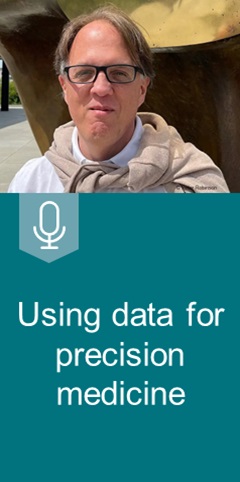Advertisement

Document › Details
Roche. (1/12/18). "Press Release: Roche’s Ocrevus (ocrelizumab) Approved in the European Union for Relapsing Forms of Multiple Sclerosis and Primary Progressive Multiple Sclerosis". Basel.
 |
Region | EU (European Union) |
 |
Organisation | Roche (Group) |
| Organisation 2 | European Commission (EC) | |
| Group | EU (govt) | |
 |
Product | Ocrevus® |
| Product 2 | Rebif® | |
 |
Person | Horning, Sandra (Roche 201401–201912 CMO + Head Global Product Development joined 2009 RETIRED 12/19) |
| Person 2 | Giovannoni, Gavin (Univ London 201009 Professor Barts and London School of Medicine and Dentistry) | |
> First and only approved disease-modifying medicine for people in the European Union (EU) with early primary progressive multiple sclerosis (PPMS)
> An important new treatment option for people with active relapsing forms of MS (RMS) that significantly suppressed three major markers of disease activity and disability progression compared with Rebif (interferon beta-1a)
> A favourable benefit-risk profile demonstrated in three large Phase III studies with a diverse patient population, including those early in the disease
> OCREVUS is administered by intravenous infusion every six months, with no routine testing between dosing
Roche (SIX: RO, ROG; OTCQX: RHHBY) announced today that the European Commission (EC) has granted marketing authorisation for OCREVUS® (ocrelizumab) for patients with active relapsing forms of multiple sclerosis defined by clinical or imaging features and for patients with early primary progressive multiple sclerosis in terms of disease duration and level of disability, and with imaging features characteristic of inflammatory activity. Multiple sclerosis (MS) affects approximately 700,000 people in Europe, of which around 96,000 have the highly disabling primary progressive form.1,2 Most people with MS have a relapsing form (RMS) or primary progressive MS (PPMS) at diagnosis.3
“For people in Europe living with MS, today’s approval of OCREVUS by the European Commission signifies an important advance in the treatment of their disease,’’ said Sandra Horning, MD, Roche’s Chief Medical Officer and Head of Global Product Development. “OCREVUS is the first medicine to be approved for primary progressive MS, a debilitating form in which irreversible disability accumulates rapidly, and it provides a highly efficacious treatment option for people with relapsing forms of MS. We are committed to working with member states to provide access as quickly as possible to people with RMS and PPMS who may benefit from OCREVUS.”
“It is great news that OCREVUS, which has the potential to be a significant game changer in how we think about and treat MS, has been approved in the European Union today,” said Gavin Giovannoni, Professor of Neurology at Barts and The London School of Medicine and Dentistry, Queen Mary University of London. “Until OCREVUS, people with primary progressive MS, who often have to rely on a cane or wheelchair, give up work or have carers look after them, have not had an approved treatment to slow the progression of their disease. People with relapsing forms of MS often have to make difficult trade-off choices between safety and higher efficacy. OCREVUS is given every six months without the need for onerous monitoring, which we hope will allow people to live their lives without thinking about their treatment every day or every week.”
The EU approval is based on data from three pivotal Phase III studies from the ORCHESTRA trial programme of 2,388 patients who met primary and nearly all key secondary endpoints. Data from two identical Phase III studies in relapsing forms of MS (OPERA I and OPERA II) showed OCREVUS demonstrated superior efficacy with approximately 80 percent of patients relapse free and significantly slower progression of the disease compared with high-dose interferon beta-1a (Rebif®) over the two-year controlled treatment period. OCREVUS also significantly increased the chance of a patient having no evidence of disease activity (NEDA; brain lesions, relapses and worsening of disability) by 64 percent in OPERA I and 89 percent in OPERA II compared with high-dose interferon beta-1a (p<0.0001 and p<0.0001).
In a separate PPMS Phase III study (ORATORIO), OCREVUS was the first and only treatment to significantly slow disability progression and reduce signs of disease activity in the brain (MRI lesions) compared with placebo with a median follow-up of three years. Patients treated with OCREVUS were 24 percent less likely to have disability progression for three months and 25 percent less likely to have disability progression for six months (p=0.0321 and p=0.0365, respectively). OCREVUS also significantly slowed the progression of walking impairment by 29.4 percent, measured by the timed 25-foot walk, compared with placebo (p=0.0404).
The most common side effects associated with OCREVUS in all Phase III studies were infusion reactions and upper respiratory tract infections, which were mostly mild to moderate in severity.
OCREVUS has been approved for use in countries across North America, South America, the Middle East, Eastern Europe, as well as in Australia and Switzerland. Over 30,000 people have been treated with OCREVUS to date.
About OCREVUS (ocrelizumab)
OCREVUS is a humanised monoclonal antibody designed to target CD20-positive B cells, a specific type of immune cell thought to be a key contributor to myelin (nerve cell insulation and support) and axonal (nerve cell) damage. This nerve cell damage can lead to disability in people with multiple sclerosis (MS). Based on preclinical studies, OCREVUS binds to CD20 cell surface proteins expressed on certain B cells, but not on stem cells or plasma cells, and therefore important functions of the immune system may be preserved.
OCREVUS is administered by intravenous infusion every six months. The initial dose is given as two 300 mg infusions given two weeks apart. Subsequent doses are given as single 600 mg infusions.
About the OPERA I and OPERA II studies in relapsing forms of MS
OPERA I and OPERA II are Phase III, randomised, double-blind, double-dummy, global multi-centre studies evaluating the efficacy and safety of OCREVUS (600 mg administered by intravenous infusion every six months) compared with interferon beta-1a (44 mcg administered by subcutaneous injection three times per week) in 1,656 people with relapsing forms of MS. In these studies, relapsing MS (RMS) was defined as relapsing-remitting MS (RRMS) and secondary progressive MS (SPMS) with relapses. A similar proportion of patients in the OCREVUS group experienced serious adverse events and serious infections compared with patients in the high-dose interferon beta-1a group in the RMS studies.
About the ORATORIO study in primary progressive MS
ORATORIO is a Phase III, randomised, double-blind, global multi-centre study evaluating the efficacy and safety of OCREVUS (600 mg administered by intravenous infusion every six months; given as two 300 mg infusions two weeks apart) compared with placebo in 732 people with primary progressive MS (PPMS). The blinded treatment period of the ORATORIO study continued until all patients had received at least 120 weeks of either OCREVUS or placebo and a predefined number of confirmed disability progression (CDP) events was reached overall in the study. A similar proportion of patients in the OCREVUS group experienced adverse events and serious adverse events compared with patients in the placebo group in the PPMS study.
About OCREVUS pivotal Phase III trial results
A summary of the data from the OPERA I, OPERA II and ORATORIO studies that support this approval is below.
Key data in RMS patients treated with OCREVUS showed:
> A 46 percent and 47 percent relative reduction in the annualised relapse rate (ARR) compared with interferon beta-1a over the two-year period in OPERA I and OPERA II, respectively (p<0.0001 and p<0.0001).
> A 40 percent relative risk reduction in confirmed disability progression (CDP) sustained for 12 weeks compared with interferon beta-1a in a pooled analysis of OPERA I and OPERA II, as measured by the Expanded Disability Status Scale (EDSS) (p=0.0006).
> A 94 percent and 95 percent relative reduction in the total number of T1 gadolinium-enhancing lesions compared with interferon beta-1a in OPERA I and OPERA II, respectively (p<0.0001 and p<0.0001).
> A 77 percent and 83 percent relative reduction in the total number of new and/or enlarging T2 lesions compared with interferon beta-1a in OPERA I and OPERA II, respectively (p<0.0001 and p<0.0001).
> A 64 percent and 89 percent relative increase in the proportion of patients with No Evidence of Disease Activity (NEDA) compared with interferon beta-1a in OPERA I and OPERA II, respectively (p<0.0001 and p<0.0001).
Key data in PPMS patients treated with OCREVUS showed:
> A 24 percent relative risk reduction in CDP sustained for at least 12 weeks compared with placebo, as measured by the EDSS (p=0.0321).
> A 25 percent relative risk reduction in CDP sustained for at least 24 weeks compared with placebo, as measured by the EDSS (p=0.0365).
> A 29.4 percent relative reduction in progression rate of walking impairment compared with placebo over 120 weeks measured by the timed 25-foot walk (p=0.0404).
> A 3.4 percent reduction in volume of brain hyperintense T2 lesions compared with a 7.4 percent increase in volume in placebo-treated patients over 120 weeks (p<0.0001).
The most common side effects associated with OCREVUS in all Phase III studies were infusion reactions and upper respiratory tract infections, which were mostly mild to moderate in severity.
About multiple sclerosis
Multiple sclerosis (MS) is a chronic disease that affects an estimated 2.3 million people around the world, for which there is currently no cure.4,5 MS occurs when the immune system abnormally attacks the insulation and support around nerve cells (myelin sheath) in the brain, spinal cord and optic nerves, causing inflammation and consequent damage. This damage can cause a wide range of symptoms, including muscle weakness, fatigue and difficulty seeing, and may eventually lead to disability.6,7,8 Most people with MS experience their first symptom between 20 and 40 years of age, making the disease a leading cause of non-traumatic disability in younger adults.5
Relapsing-remitting MS (RRMS) is the most common form of the disease and is characterised by episodes of new or worsening signs or symptoms (relapses) followed by periods of recovery.9,10 Approximately 85 percent of people with MS are initially diagnosed with RRMS.3 The majority of people who are diagnosed with RRMS will eventually transition to secondary progressive MS (SPMS), in which they experience steadily worsening disability over time.3 Relapsing forms of MS (RMS) include people with RRMS and people with SPMS who continue to experience relapses.
Primary progressive MS (PPMS) is a debilitating form of the disease marked by steadily worsening symptoms but typically without distinct relapses or periods of remission.11 Approximately 15 percent of people with MS are diagnosed with the primary progressive form of the disease.3 Disability accumulates twice as fast in PPMS as in RMS, meaning that people with PPMS may have to rely on mobility aids or become wheelchair bound, are unable to work, and need carers to look after them sooner.12 Additionally, a recent article in Multiple Sclerosis Journal noted that the quality of life for a person with MS with severe disability (Expanded Disability Status Scale >7), as measured by EQ-5D mean utility scores, ranks among the worst for chronic conditions.13 There is a profound burden on people living with PPMS and a clear clinical need to initiate treatment as early as possible to control disease activity and disability progression.
People with all forms of MS experience disease activity – inflammation in the nervous system and permanent loss of nerve cells in the brain – even when their clinical symptoms aren’t apparent or don’t appear to be getting worse.14 An important goal of treating MS is to reduce disease activity as soon as possible to slow how quickly a person’s disability progresses.15 Despite available disease-modifying treatments (DMTs), some people with RMS continue to experience disease activity and disability progression.
About Roche in neuroscience
Neuroscience is a major focus of research and development at Roche. The company’s goal is to develop treatment options based on the biology of the nervous system to help improve the lives of people with chronic and potentially devastating diseases. Roche has more than a dozen investigational medicines in clinical development for diseases that include multiple sclerosis, Alzheimer’s disease, spinal muscular atrophy, Parkinson’s disease and autism.
About Roche
Roche is a global pioneer in pharmaceuticals and diagnostics focused on advancing science to improve people’s lives. The combined strengths of pharmaceuticals and diagnostics under one roof have made Roche the leader in personalised healthcare – a strategy that aims to fit the right treatment to each patient in the best way possible.
Roche is the world’s largest biotech company, with truly differentiated medicines in oncology, immunology, infectious diseases, ophthalmology and diseases of the central nervous system. Roche is also the world leader in in vitro diagnostics and tissue-based cancer diagnostics, and a frontrunner in diabetes management.
Founded in 1896, Roche continues to search for better ways to prevent, diagnose and treat diseases and make a sustainable contribution to society. The company also aims to improve patient access to medical innovations by working with all relevant stakeholders. Thirty medicines developed by Roche are included in the World Health Organization Model Lists of Essential Medicines, among them life-saving antibiotics, antimalarials and cancer medicines. Roche has been recognised as the Group Leader in sustainability within the Pharmaceuticals, Biotechnology & Life Sciences Industry nine years in a row by the Dow Jones Sustainability Indices (DJSI).
The Roche Group, headquartered in Basel, Switzerland, is active in over 100 countries and in 2016 employed more than 94,000 people worldwide. In 2016, Roche invested CHF 9.9 billion in R&D and posted sales of CHF 50.6 billion. Genentech, in the United States, is a wholly owned member of the Roche Group. Roche is the majority shareholder in Chugai Pharmaceutical, Japan. For more information, please visit www.roche.com.
All trademarks used or mentioned in this release are protected by law. Rebif is a registered trademark of Merck KGaA and EMD Serono, Inc.
References
1. European Multiple Sclerosis Platform. MS Facts. Available at: http://www.emsp.org/about-ms/
2. Estimated from http://www.emsp.org/wp-content/uploads/2015/08/MS-in-EU-access.pdf as 15% of total MS cases per country.
3. National Multiple Sclerosis Society. Types of MS. Available at http://www.nationalmssociety.org/What-is-MS/Types-of-MS.
4. National Institutes of Health-National Institute of Neurological Disorders and Stroke. Multiple Sclerosis: Hope Through Research. Available at: https://www.ninds.nih.gov/Disorders/Patient-Caregiver-Education/Hope-Through-Research/Multiple-Sclerosis-Hope-Through-Research.
5. Multiple Sclerosis International Federation. (2013). Atlas of MS 2013. Available at: http://www.msif.org/about-us/advocacy/atlas/.
6. Ziemssen T. (2005). Modulating processes within the central nervous system is central to therapeutic control of multiple sclerosis. J Neurol, 252(Suppl 5), v38-v45.
7. Hauser S.L. et al. (2012). Multiple sclerosis and other demyelinating diseases. In Harrison’s Principles of Internal Medicine (pp.3395-3409). New York, NY: McGraw Hill Medical.
8. Hadjimichael O. et al. (2007). Persistent pain and uncomfortable sensations in persons with multiple sclerosis. Pain, 127(1-2):35-41.
9. Lublin F.D., Reingold S.C. (1996) Defining the clinical course of multiple sclerosis: results of an international survey. National Multiple Sclerosis Society (USA) Advisory Committee on Clinical Trials of New Agents in Multiple Sclerosis. Neurology, 46(4):907–11.
10. Lublin F.D. et al. (2014). Defining the clinical course of multiple sclerosis. Neurology, 83(3):278-86.
11. Multiple Sclerosis International Federation. Types of MS. Available at https://www.msif.org/about-ms/types-of-ms/.
12. Raghavan K., et al. (2015). Progression rates and sample size estimates for PPMS based on the CLIMB study population. Mult Scler, 21(2):180-8.
13. Kobelt, Gisela New insights into the burden and costs of multiple sclerosis in Europe 2017 Available at: http://journals.sagepub.com/doi/pdf/10.1177/1352458517694432
14. Erbayat A, et al. (2013). Reliability of classifying multiple sclerosis disease activity using magnetic resonance imaging in a multiple sclerosis clinic. JAMA Neurol, 70(3):338-44.
15. MS Brain Health. Time Matters in Multiple Sclerosis. Available at http://msbrainhealth.org/perch/resources/time-matters-in-ms-report-may16.pdf.
Record changed: 2023-06-05 |
Advertisement

More documents for Roche (Group)
- [1] Roche. (4/11/24). "Press Release: Roche Granted FDA Breakthrough Device Designation for Blood Test to Support Earlier Alzheimer's Disease Diagnosis". Basel....
- [2] Freenome, Inc.. (2/15/24). "Press Release: Freenome Raises $254 Million in New Funding to Accelerate its Platform for Early Cancer Detection". South San Francisco, CA....
- [3] PathAI Inc.. (2/13/24). "Press Release: PathAI Announces Exclusive Collaboration with Roche Tissue Diagnostics to Advance AI-enabled Interpretation for Companion Diagnostics". Boston, MA....
- [4] Repare Therapeutics Inc.. (2/12/24). "Press Release: Repare Therapeutics to Regain Global Rights to Camonsertib". Cambridge, MA & Montréal....
- [5] Hookipa Pharma Inc.. (1/29/24). "Press Release: Hookipa Pharma Provides Update on Business Priorities and Oncology Partnership Programs". New York, NY & Vienna....
- [6] Repare Therapeutics Inc.. (1/25/24). "Press Release: Repare Therapeutics Announces Achievement of $40 Million Roche Clinical Milestone Payment". Cambridge, MA & Montréal....
- [7] Roche Deutschland Holding GmbH. (1/10/24). "Press Release: Prof. Hagen Pfundner wird zum 1. Mai 2024 Vorsitzender der Roche Deutschland Holding GmbH"....
- [8] Remix Therapeutics, Inc.. (1/3/24). "Press Release: Remix Therapeutics Enters Collaboration with Roche for the Discovery and Development of Small Molecule Therapeutics Modulating RNA Processing". Watertown, MA....
- [9] MediLink Therapeutics (Suzhou) Co., Ltd.. (1/2/24). "Press Release: MediLink Therapeutics Announces Worldwide Collaboration and License Agreement with Roche to Develop Next-generation Antibody Drug Conjugate in Oncology". Suzhou....
- [10] Roche. (12/29/23). "Press Release: Roche Enters into a Definitive Agreement to Acquire LumiraDx's Point of Care Technology Combining Multiple Diagnostic Modalities on a Single Platform". Basel....
To subscribe to our free, monthly newsletter for the European life sciences, please send an e-mail to info@iito.de and simply fill the subject line with the word »LSE Newsletter«
Find more infos about advertising at [iito] web portals in our media flyer [iito] in a Nutshell [PDF file]
Advertisement

» top
![[LSE] Life-Sciences-Europe.com - The European Life Sciences Web Portal](/images/basics/lse-life-sciences-europe-portal-logo.svg)
![Picture [iito] LSE iitoLifeScience Life Sciences Mass Spec 120x120px](/banner/iito-business-intelligence-20230710-120-120-twitter-iitolifescience-germany-europe-mass-spec.jpg)


![Picture [LSUS] Life-Sciences-USA.com – The Business Web Portal 120x600px](/banner/iito-20181119-120-600-lsus-life-sciences-usa-com.jpg)





